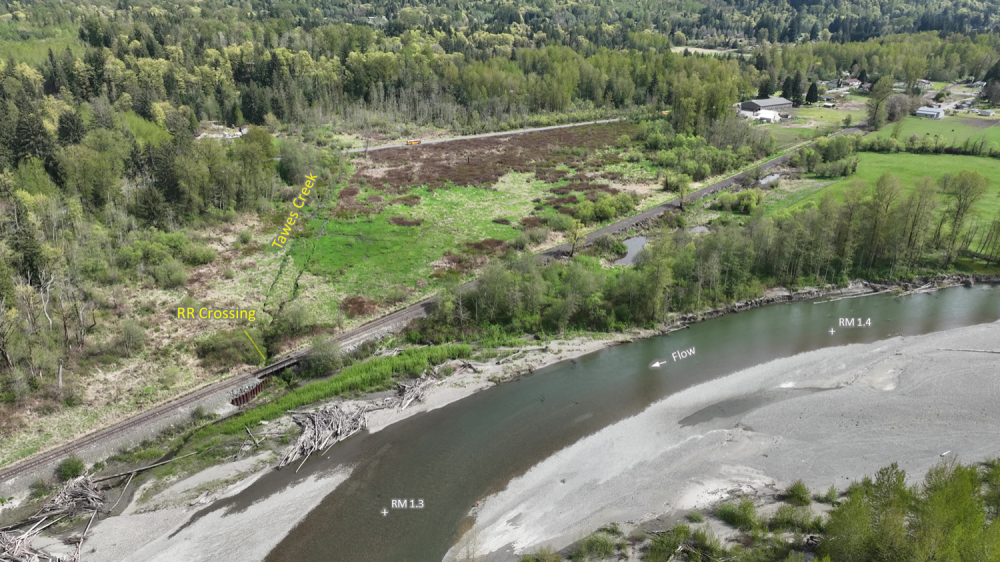The Upper Van Zandt Restoration Project (formerly the Black Slough Restoration Project) is located on the South Fork (SF) Nooksack River near Van Zandt, river mile (RM) 1.3 and 3, and
the Potter Road Bridge. This project is sponsored by the Lummi Nation Natural Resources Department (LNR). Downstream portions of the Black Slough tributary
channel (entering the SF at RM 2) may be included in the project design depending on landowner support. The Upper Van Zandt Project aims
to improve habitat conditions for threatened SF Nooksack early Chinook (chinook)
salmon and reduce flood risk throughout the area.
LNR is building a partnership with Burlington Northern Santa Fe Railroad Company (BNSF) and other adjacent landowners. The project team met individually with landowners in November to discuss specific project concepts. Another field visit is being scheduled in February with interested landowners.
Latest Design Concept
LNR and NSD has shared the latest design iteration during recent site visits with adjacent landowners. This version has been vetted by most stakeholders. The preferred alternative is likely similar to this version. However, more modeling is required to ensure that it can be approved by FEMA for no-rise on insurable structures.
Selected alternative after 1st design run
4.6MB
(2025) NSD
Concept presentation community workshop was held on January 29th at Van Zandt Community Center. Here is the meeting presentation:
Three conceptual designs
29.3MB
(2025) NSD
The project team is reviewing the feedback from stakeholders at the January meeting 29th meeting. A preferred alternative and associated hydraulic modeling will be shared soon.
Community Workshop #1 Meeting Summaries and Existing Conditions Report
 Project Area Site Maps
Project Area Site Maps Vicinity Map
Vicinity MapUpper Van Zandtproject reach looking downstream towards Potter Rd Bridge
Community Outreach
The Upper Van Zandt Restoration Project, led by LNR and supported by its engineering team, Natural Systems Design + Coastal Geologic Services (NSD),
and outreach consultant, Triangle (project team), is one of several similar projects
currently underway in the area that you may already be aware of. The project is being planned in close coordination with these other efforts, which include:
- Skookum Edfro Phase 1 Adaptive Management, Lummi Nation (RM 14.2 to 14)
- Skookum Edfro Phase 3 Restoration Project, Lummi Nation (RM 14 to
12.7)
- South Fork Nooksack River Fish Camp (Ts’eq) Reach
Integrated Design Project, Nooksack Tribe and Whatcom County as co-leads (RM
9.5 to 7.2)
- South Fork Nooksack (Nuxw7íyem) Homesteader Phase 2 Restoration Project, Nooksack Tribe (RM 6.5 to 5.7).
- South Fork Nooksack (Nuxw7íyem) Hardscrabble/Todd Reach
Restoration Project, Nooksack Tribe (RM 5.1 to 3.2)
 Close-up of channel and bank conditions
Close-up of channel and bank conditions This is an opportunity to work with BNSF to build a railroad trestle.
This is an opportunity to work with BNSF to build a railroad trestle.Current Work
The project team is currently assessing
geomorphic and hydraulic conditions in the river channel and adjacent banks and
floodplains. Team members conducted site visits in April for data collection necessary to complete these assessments. You may have received a phone
call, email, or letter asking for permission to access the river via your
property. There will be more site visits as the project progresses, and we will always reach out first. LNR, NSD, and the Nooksack Tribe (for the Hardscrabble Project) held a mid-July design kickoff meeting to discuss existing conditions and strategize ideas for proposed conditions. The tribes are working together, keeping the two projects timelines together. .
Next Steps
The engineering team will build upon existing understanding of geomorphic and hydrologic processes in the SFNR developed from recent project experience supporting the Nooksack Tribe with the Hardscrabble-Todd Reach and Homesteader Reach Restoration designs immediately upstream for the Upper Van Zandt project reach. The design team will collaborate with LNR to refine project objectives and identify project constraints.
A suite of conceptual design alternatives will be developed to include design elements such as removal of riprap bank hardening, riparian planting, targeted excavation to increase access to or establish new off-channel habitat, placement of ELJs, side channel creation, and suggestions for targeted land acquisition. At the conceptual design phase NSD will work to identify and advance the restoration potential of the reach, irrespective of FEMA floodplain and other permitting constraints. The alternatives will be presented to stakeholders during community workshops. Geomorphic, hydraulic, habitat, and climate change analyses will be completed to inform design development. The selected alternative will then be adapted to work within FEMA floodplain and other constraints to develop Preliminary and Final (90%) Design levels. Final (90%) Design plans, Basis of Design Report, materials schedules, and cost estimates will then be prepared. A Final Planset will then be prepared for construction.
Opportunities to weigh in on various aspects of the
project, including but not limited to:
- The scope and
scale of the problems the project is intended to address.
- Thoughts and
concerns regarding results of preliminary geomorphic and hydraulic assessment.
- Techniques to reduce flooding while
increasing salmon habitat.
- Preferred
design alternative.
If you would like to schedule a phone call to discuss this project,
please e-mail outreach@triangleassociates.com
Contact
Please
feel free to contact either of the project co-leads with questions.
Alex Levell
Lummi
Nation
Natural
Resources Department
Phone: 360-410-1988 (cell)
Email: alexl@lummi-nsn.gov
Kelley Turner
Lummi Nation
Natural Resources Department
Phone: (360) 306-7244 (cell)
Email: KelleyT@lummi-nsn.gov
For information regarding engagement
opportunities, to schedule a phone call, or to be added to the Listserv,
contact
Melanie del Rosario
Triangle Associates
360-583-3412
Email: mdelrosario@triangleassociates.com
Kate Galambos
Triangle Associates
Phone: (360) 583-3408
Email:
outreach@triangleassociates.com